
- Home
- Homographs

 كلية الطب
كلية الطب
 كلية طب الاسنان
كلية طب الاسنان
 كلية الصيدلة
كلية الصيدلة
 كلية العلوم الطبية التطبيقية
كلية العلوم الطبية التطبيقية
 كلية التمريض
كلية التمريض
 كلية الطب البيطري
كلية الطب البيطري
 كلية الهندسة
كلية الهندسة
 كلية العلوم
كلية العلوم
 كلية العلوم السياحية
كلية العلوم السياحية
 كلية الادارة والاقتصاد
كلية الادارة والاقتصاد
 كلية العلوم الاسلامية
كلية العلوم الاسلامية
 كلية علوم الحاسوب وتكنولوجيا المعلومات
كلية علوم الحاسوب وتكنولوجيا المعلومات
 كلية القانون
كلية القانون
 كلية التربية للعلوم الصرفة
كلية التربية للعلوم الصرفة
 كلية التربية للعلوم الانسانية
كلية التربية للعلوم الانسانية
 كلية التربية البدنية وعلوم الرياضة
كلية التربية البدنية وعلوم الرياضة
 كلية الزراعة
كلية الزراعة
 وزارة التعليم العالي والبحث العلمي
وزارة التعليم العالي والبحث العلمي
 بوابة اور الحكومية للخدمات الالكترونية
بوابة اور الحكومية للخدمات الالكترونية
 جامعة بابل
جامعة بابل
 جامعة بغداد
جامعة بغداد
 الجامعة التكنولوجية
الجامعة التكنولوجية
 جامعة ديالى
جامعة ديالى
 جامعة الموصل
جامعة الموصل
 جامعة الكوفة
جامعة الكوفة
 جامعة البصرة
جامعة البصرة
 جامعة الانبار
جامعة الانبار
 جامعة تكريت
جامعة تكريت
 جامعة القادسية
جامعة القادسية
 جامعة النهرين
جامعة النهرين
 جامعة كركوك
جامعة كركوك
 الجامعة المستنصرية
الجامعة المستنصرية
 جامعة ميسان
جامعة ميسان
 جامعة ذي قار
جامعة ذي قار
 جامعة واسط
جامعة واسط
 جامعة تكنولوجيا المعلومات والاتصالات
جامعة تكنولوجيا المعلومات والاتصالات
 الجامعة العراقية
الجامعة العراقية
 جامعة المثنى
جامعة المثنى
 جامعة القاسم الخضراء
جامعة القاسم الخضراء
 الجامعة التقنية الوسطى
الجامعة التقنية الوسطى
 جامعة الفلوجة
جامعة الفلوجة
 جامعة الفرات الاوسط التقنية
جامعة الفرات الاوسط التقنية
 الجامعة التقنية الجنوبية
الجامعة التقنية الجنوبية
 جامعة سامراء
جامعة سامراء
 جامعة جابر بن حيان الطبية
جامعة جابر بن حيان الطبية
 جامعة الكرخ للعلوم
جامعة الكرخ للعلوم
 جامعة نينوى
جامعة نينوى
 جامعة البصرة للنفط والغاز
جامعة البصرة للنفط والغاز
 جامعة الحمدانية
جامعة الحمدانية
 الجامعة التقنية الشمالية
الجامعة التقنية الشمالية
 جامعة ابن سينا للعلوم الطبية والصيدلانية
جامعة ابن سينا للعلوم الطبية والصيدلانية
 كلية الإمام الأعظم الجامعة
كلية الإمام الأعظم الجامعة
 جامعة سومر
جامعة سومر
 جامعة تلعفر
جامعة تلعفر
 جامعة الفراهيدي
جامعة الفراهيدي